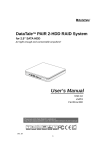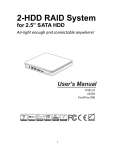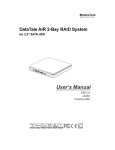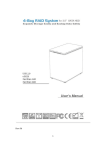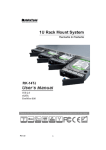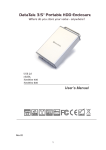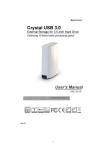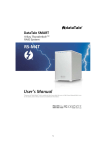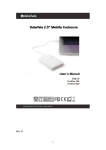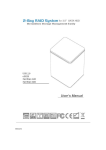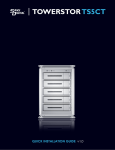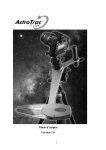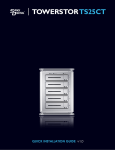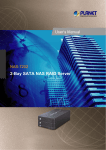Download DataTale SMART 2-Bay RAID System
Transcript
TM www.datawatchtech.com DataTale SMART 2‐Bay RAID System Smart and user-friendly data management experience User’s Manual USB 2.0 eSATA FireWire 400 FireWire 800 Please go onto Data Watch website at http://www.datawatchtech.com for the latest version of user manual. 7 Rev. 02 1 Table of Contents GENERAL INFORMATION ..............................................................................................4 Copyright......................................................................................................................................................................4 Notices And Classifications...................................................................................................................................4 Contact Us ....................................................................................................................................................................4 PRECAUTIONS FOR THE RAID SYSTEM...........................................................................5 General Precautions ................................................................................................................................................5 RAID System Precautions......................................................................................................................................5 INTRODUCTION ............................................................................................................6 Features ........................................................................................................................................................................6 System Requirement ...............................................................................................................................................6 PC......................................................................................................................................................................................... 7 MAC..................................................................................................................................................................................... 7 Optional Accessories ...............................................................................................................................................7 Package Contents......................................................................................................................................................7 SYSTEM VIEWS..............................................................................................................8 Front View ...................................................................................................................................................................8 Rear View.....................................................................................................................................................................8 Top & Cover View (Exposed)...............................................................................................................................9 INSERTING/REPLACING THE HARD DRIVES IN THE RAID SYSTEM ................................10 Fasten The Handle Onto The Hard Disk .......................................................................................................11 Place The Hard Disk Inside The RAID System ...........................................................................................14 CONNECTING THE RAID SYSTEM TO A COMPUTER......................................................16 RAID MASTER .............................................................................................................19 Installation................................................................................................................................................................19 (INSTALLATION FOR MAC & PC)........................................................................................................................19 RAID MASTER MENU ..................................................................................................20 CONFIGURATION & REBUILD ......................................................................................21 Create A RAID..........................................................................................................................................................21 Changing The Most Recent Assigned RAID Mode ....................................................................................23 Deleting An Assigned RAID Mode...................................................................................................................25 Rebuild .......................................................................................................................................................................27 Mixed RAID Statuses ............................................................................................................................................31 Device Information ...............................................................................................................................................33 NUMBER OF DISKS SUPPORTING EACH RAID MODE ...................................................34 DISK SLOT NUMBER ....................................................................................................34 LED INDICATORS .........................................................................................................34 Power LED x 1.........................................................................................................................................................34 DISK LED x 4 ............................................................................................................................................................35 SAFE REMOVAL OF THE RAID SYSTEM.........................................................................35 EXTERNAL BOOTUP.....................................................................................................36 2 PC.......................................................................................................................................................................................36 MAC...................................................................................................................................................................................36 DISK VOLUME OVER 2TB.............................................................................................36 RAID MODES...............................................................................................................37 RAID 0 (Striping) ...................................................................................................................................................37 RAID 1 (Mirroring)................................................................................................................................................38 Span (Large) ............................................................................................................................................................38 JBOD (None RAID).................................................................................................................................................39 eSATA PCI EXPRESS CARD INSTALLATION....................................................................40 System Requirements..........................................................................................................................................40 Hardware Installation..........................................................................................................................................40 Driver Installation .................................................................................................................................................41 Verify Driver Installation....................................................................................................................................41 Mac OS: ...........................................................................................................................................................................41 Windows OS:.................................................................................................................................................................41 Windows 2003 and XP:............................................................................................................................................42 Windows 2000:............................................................................................................................................................42 Q&As ..........................................................................................................................43 General .......................................................................................................................................................................43 Daisy Chain...............................................................................................................................................................43 Discrepancy in Reported & Actual Size Capacity......................................................................................43 Disk Capacity ...........................................................................................................................................................44 Old Disks....................................................................................................................................................................44 RAID MASTER: Connection Restriction........................................................................................................44 Rebuild .......................................................................................................................................................................44 Over 2TB....................................................................................................................................................................45 Linux ...........................................................................................................................................................................46 LEDs: Red ..................................................................................................................................................................46 APPENDIX: SPECIFICATIONS........................................................................................47 3 GENERAL INFORMATION Copyright Copyright @ 2011 Data Watch Technologies Co., Ltd. All rights reserved. No part of this publication may be reproduced, stored in a retrieval system, or transmitted in any form or by any means, electronic, mechanical, photocopying, recording or otherwise, without the prior written consent of Data Watch Technologies Co., Ltd. The product information provided in this manual is subject to change without prior notice and does not represent a commitment on behalf of the vendor. The vendor assumes no liability or responsibility for any errors that may appear in this manual. Firmware, software, images, and descriptions may vary slightly from actual products. Notices And Classifications FCC-B Radio Frequency Interference Statement This device complies with Part 15 of the FCC rules. Operation is subject to the following two conditions: This device may not cause harmful interference. This device must accept any interference received, including interference that may cause undesired operation. This equipment has been tested and found to comply with the limits for a Class B digital device, pursuant to Part 15 of the FCC rules. These limits are designed to provide reasonable protection against harmful interference when the equipment is operated in a commercial environment. This equipment generates uses and can radiate radio frequency energy and, if not installed and used in accordance with the instruction manual, may cause harmful interference to radio communications. Contact Us We are committed to offer economical, high-quality connectivity and storage enclosure solutions to the market. Any questions, inquiries or comments are highly welcomed. For the latest version of the User Manual & Technical Support, please go to our website at www.datawatchtech.com. Data Watch Technologies Co., Ltd. 3F, No. 60, Lane 321, Yang Guang St., Nei Hu, Taipei 114 Taiwan Tel: +886-2-8797-8868 Fax: +886-2-8797-4801 Email: [email protected] 4 PRECAUTIONS FOR THE RAID SYSTEM General Precautions ¾ The main circuit board of the RAID System is susceptible to static electricity. Proper grounding is required to prevent electrical damage to the RAID System or other connected devices, including the host computer. Always place the RAID System on a smooth surface and avoid all dramatic movement, vibration and percussion. ¾ Do NOT place the RAID System close to magnetic devices (such as a mobile phone), high-voltage devices (such as a hair dryer), or near a heat source (such as on the dashboard of a car or any place where it will be exposed to direct sunlight). ¾ Use only the power supply cable provided with the RAID System. ¾ Do NOT attempt to service this RAID System yourself. Please contact Technical Support in regards to any parts other than the ones already mentioned in the “Installation” section of this User’s Manual. ¾ Do NOT block the ventilation. Proper airflow is required to ensure reliable operation and to prevent overheating. ¾ Do NOT allow water to enter the RAID System. ¾ Do unplug the RAID System from the electrical outlet when not in use to provide an ecological friendly environment. RAID System Precautions ¾ Installation of RAID MASTER software in the host computer is required for proper operation. ¾ Installation of additional equipment in the host computer may be required. Visit our website at www.datawatchtech.com to download the latest product information updates. ¾ Any loss, corruption, or destruction of data is the sole responsibility of the user of the RAID System. Under no circumstances will the manufacturer be held liable for the recovery or restoration of any data. 5 INTRODUCTION Thank you for purchasing the DataTale SMART 2-Bay RAID System. The DataTale SMART RAID System with RAID MASTER (Graphic User Interface) provides substantial storage capacity and distinctive RAID configuration options in a desktop storage device. The RAID MASTER allows easy configuration of RAID Modes: JBOD (None RAID), RAID 0 (Striping), RAID 1 (Mirroring), and Span (Large). Please thoroughly read and follow the instructions provided in this manual. Failure to do so may result in damage to the RAID System, and any or all of the connected devices. Features Compatible with all 3.5-inch SATA I, II, III Hard disks Connects flexibly via Hi-Speed USB (USB2.0 connection), IEEE 1394a (FireWire 400), IEEE 1394b (FireWire 800 connection), or eSata (eSATA connection) Provides JBOD (None RAID), RAID 0 (Striping), RAID 1 (Mirroring), and SPAN (Large) for effective storage management Supports Rebuild under RAID 1 mode Configures RAID modes easily using RAID MASTER, no IT expertise required Monitors System status via LED indicators or RAID MASTER Combines RAID System and 1394 repeater functionality Supports over 2TB storage capacity, with no performance degradation Prevents over-tightened hard disks with auto-limiting segmented screws Features a trayless function with the SmartGuider* Dissipates heat efficiently with aluminum housing Maximizes airflow with a silent fan, SmartGuider*, and well-matched mechanical design SmartGuider is a trayless device that utilizes the simplicity of a handle and screws. The integrated handle is attached onto the hard disk with auto-limiting segmented screws. Then, the entire hard disk setup can be slide into the RAID System by aligning the screws with its specially designed guides. This enables flexibility for easy hard disk removal and insertion. System Requirement To use the DataTale SMART RAID System, the minimum system configuration in the host computer require the following: 6 PC 500MHz or faster CPU 512MB of RAM Microsoft Windows 2000, XP, 2003, Vista, 2008, 7 or higher One available eSATA, USB 2.0, IEEE 1394a, or IEEE 1394b port MAC Macintosh PowerPC or Intel Core Duo processor 512MB of RAM Mac OS X 10.4 (Intel/PowerPC) or higher One available eSATA, USB 2.0, IEEE 1394a, or IEEE 1394b port Time Machine Compatible 3.5-inch SATA compatible hard drive is required for the RAID System. Once the hard disks are formatted, the actual available storage capacity can vary depending on the selected operating environment (normally 5-10 % less). Optional Accessories eSATA PCI, PCI-X, or PCI-Express Card Package Contents RAID System unit HDD screws x 8 Quick Start Guide FireWire 800 Cable FireWire 400 Cable 2 Handles CD 2 spare HDD screws provided on back part of cover lid USB Type B to A Cable eSATA Cable External Power Supply Please keep all package contents and packaging material in the event that the product must be returned. 7 SYSTEM VIEWS Front View 1 LED Indicators Disk 1 Disk 2 Power The status indication of each LED indicator is listed under the LED INDICATORS section. Rear View 2 FireWire 800 (2 ports) 3 FireWire 400 6 Power Switch eSATA 5 eSATA Port DC IN 4 USB 2.0 Type B 8 Lock Slot/Port 8 7 DC IN Top & Cover View (Exposed) 10 “Front” Indicator 9 11 2 Spare HDD Screws 13 Handles 12 Disk Slots (indicates Disk 1 through Disk 2) 9 INSERTING/REPLACING THE HARD DRIVES IN THE RAID SYSTEM To assemble the RAID System, please follow the steps listed in the instructions below: 1. Place the RAID System with its Front View facing you. Position both hands on the front edge. Simultaneously, push the lid in the direction away from you, front to back, using your thumbs. A “click” sound would indicate release of the top lid’s security clasp. 2. Lift the top lid up to remove and expose the Top View (or Disk slots). Take out the handles from the enclosure itself and locate the HDD screws in the packaging box. 10 Fasten The Handle Onto The Hard Disk 3. Place the hard disk with the metal cover side facing up and ensure that the interface connectors are oriented toward your left side. Connectors 4. Position the handle to the hard disk end, which is facing away from the interface connectors, and align it with the screw hole openings. Connectors 11 5. Fasten the handle onto the hard disk by inserting and tightening the screws, the left one first, then the right one. Right Left 6. Now, flip the hard disk so it is facing you with the PCBA (Printed Circuit Board) on top and the unfasten handle side facing you. 12 7. Insert and tighten the screws, the left one first, then the right one. Right Left 8. Finally, test sliding the handle to make sure the holes glide smoothly on the screw guides. Repeat the same procedures for the second hard disk. The auto-limiting segmented screws are designed to prevent the hard disks or/and the handles from damages due to over-tightening. Furthermore, this design makes the handle slide easily without any tightness. 13 Place The Hard Disk Inside The RAID System 9. Hold the HDD with the metal cover side facing you and the handle attached on the upward position. If the HDD is inserted on its reverse side, the SmartGuider* System won’t be able to align and the HDD cannot be inserted. 10. Align the handle with the guide rails and slide the HDD into the indicated slot. Firmly push downward until a “thump” sound is heard. Repeat the same procedures for the second HDD. In most cases, you would need to firmly push the HDD to a close until a “thump” sound is heard. 14 11. Place the RAID System with its Front View facing you and the top lid on. Position both hands on the back edge of the top lid. Simultaneously, push the lid firmly downward and toward you, back to front. A “click” sound would indicate grasp of the top lid security clasp. 12. Now, the RAID System is ready for connection to a computer! Installing HDDs OK! 15 CONNECTING THE RAID SYSTEM TO A COMPUTER To connect the RAID System, please complete the following steps: DC IN eSATA 1. Connect the AC/DC Power Adapter. DC IN eSATA 2. Insert both ends of the USB 2.0, eSATA, FireWire 400, or FireWire 800 cable(s) into the corresponding port of the RAID System and the host. The RAID System should only be connected to a host computer via one interface. Connection of the RAID System to a computer via two or more interfaces simultaneously is highly not recommended, especially for data transfers. 16 DC IN eSATA 3. Turn the Power Switch to the “on” position. 4. When connected, the Power LED light will become steadily green. If the HDDs are inside the RAID System, the Disk LED lights will become steadily white. If there are no HDDs inside the RAID System, the Disk LED lights will not turn on. 17 5. You are now ready to begin using your RAID System! Installing HDDs OK! Due to compatibility issues, if you use the eSATA interface to do the data transfer, the Silicon Image eSATA host controller is highly recommended. When using FireWire 800, you can “Daisy chain” and connect other computer hardware or digital devices to your System (such as digital video camera, another HDD, DVD writer, and much more). Please see “Daisy Chain” under “Q&As” Section for more information. 18 RAID MASTER The RAID MASTER is a newly-designed GUI Software specifically for our DataTale SMART RAID System. The drivers of the RAID MASTER for both PC and MAC are provided via CD included in the Package. The RAID MASTER provides a more convenient yet modern way to manage your RAID System. Installation To install the RAID Master via CD, please insert the provided CD in the package and complete the following steps: (INSTALLATION FOR MAC & PC) Please follow the steps listed in the instructions provided below: 1. There will be two (2) folders inside the CD. One is for “2-Bay” RAID Systems, and the other is for “4-Bay” RAID Systems. Please double click on the “2-Bay” folder to open it. 2. Once opened, please select the appropriate driver based on your host system’s OS, copy the driver onto your Desktop. Then, double click on the driver file to decompress it. Finally, double click on RAID MASTER and its menu should appear. The RAID MASTER can only be installed and operated via USB 2.0 or FireWire 800. If you choose to use eSATA connection for data transfers, please set up the RAID configuration via USB or FireWire connections first. 19 RAID MASTER MENU CONFIGURATION & REBUILD: o Shows a single connected RAID System, or multiple connected RAID Systems. o Supports RAID configurations under Configuration and Rebuild options o Provides hard disk(s)’ current RAID status o Indicates individual hard disk (s)’ current disk information DEVICE INFORMATION: o Provides the basic information of the RAID System itself, once the RAID System is connected to the host: the Device’s information, and serial number for each inserted hard disks. 20 CONFIGURATION & REBUILD Create A RAID To setup RAID functions for the RAID System, please complete the following steps: Creating a new RAID mode will delete all data stored on the hard disk(s). If you have important saved data in the hard drives, backup all data before formatting the RAID Mode. 1. Under the “Configuration” option tab, select the RAID mode preferred and click the “Create RAID/Apply” icon. If cannot see what is/are connected as part of the RAID System, press the “Refresh” button on top of the first sub-menu (top). The information should appear afterwards. Please review the RAID mode options under “RAID MODES” to choose the best suitable RAID mode for your needs and desire. If the number of inserted hard disk does not qualify the quantity needed for a particular RAID mode, the 21 RAID MASTER’S “Create RAID/Apply” icon will not be available to click (faint image). If the OS of the host can support more than 2TB hard disk(s) storage capacities and the hard disk(s) is/are over 2TB, remember to check the “Over 2TB” option under the “Configuration” option tab. Please see “Over 2TB” section under Q&As for more information. Please review the “DISK VOLUME OVER 2TB” section of the User’s Manual for OS support information. 2. Once selected, the RAID MASTER will give an alert popup window stating “all data on disk will be lost. Proceed?”. Click on “Yes” icon to confirm. 3. Once confirmed, the RAID MASTER will begin processing the chosen RAID Mode onto the chosen hard disk(s). Once the process is completed, the “RAID Status” and “Disk Information” should reflect the newly assigned RAID mode. The RAID System is now ready to be used under the preferred RAID Mode! 22 Changing The Most Recent Assigned RAID Mode To change the most recent assigned RAID Mode for the inserted hard disk(s) of the RAID System, please complete the following steps: Changing the RAID Mode will delete all data stored on the hard disk(s). If you have important saved data in the hard drives, backup all data before changing the RAID Mode. 1. Under the “Configuration” option tab, select the RAID mode prefer changing to and click the “Create RAID/Apply” icon. If the host can support more than 2TB hard disk(s) storage capacities and the hard disk(s) is/are over 2TB, remember to check the “Over 2TB” option under the “Configuration” option tab. Please see “Over 2TB” section under Q&As for more information. Please review the “DISK VOLUME OVER 2TB” section of the User’s Manual for OS support information 23 2. Once selected, the RAID MASTER will give an alert popup window stating, “all data on disk will be lost. Proceed?” Click on “Yes” icon to confirm. 3. Once confirmed, the RAID MASTER will begin processing the chosen RAID Mode onto the chosen hard disk(s). Once the process is completed, the “RAID Status” and “Disk Information” should reflect the newly assigned RAID mode. The chosen hard disk(s) RAID is/are now ready to be used under the new preferred RAID Mode! 24 Deleting An Assigned RAID Mode To delete an assigned RAID Mode for the inserted hard disk(s) of the RAID System, please complete the following steps: Deleting a RAID Mode will delete all data stored on the hard disk(s). If you have important saved data in the hard drives, backup all data before deleting the RAID Mode. 1. Under the “Configuration” option tab, click the “Delete RAID” icon to change the hard disk(s) into JBOD (None RAID) disks. 25 2. Once selected, the RAID MASTER will give an alert popup window stating, “all data on disk will be lost. Proceed?” Click on “Yes” icon to confirm. 3. Once confirmed, the RAID MASTER will begin erasing the old RAID Mode for the chosen hard disk(s). Once the process is completed, the “RAID Status” and “Disk Information” should reflect the chosen hard disk(s) as JBOD (None RAID). The chosen hard disk(s) RAID is/are now ready to be used under the new preferred RAID Mode! 26 Rebuild To setup Rebuild under RAID 1 mode, please complete the following steps: The use of identical hard disks from the same manufacturer, with the same capacity and RPM is highly recommended. 1. Under RAID 1 mode, if one of the hard disks fails or a hard disk is removed, a popup window stating “Attention! Hot Swap” will appear. Click on “Ok” icon to continue. 2. Another popup window will appear stating, “Attention! RAID 1 Degrade Mode”. Click on “Ok” to continue. 27 3. Then, the “Rebuild” option should appear. Continue by replacing the failed hard disk with a functional disk or inserting a New disk in place of the one removed. The New disk will show up as red “New” and “Not Config”. To rebuild the New disk (the new functional disk) with the data from the Old disk (the remaining functional disk) sector by sector, click on the “Rebuild ==>” icon. The New disk may be inserted into either Disk 1 or Disk 2, because the Rebuild feature can be performed in either direction. 28 4. A popup window stating, “Copy Data From Disk 1 to Disk 2. All data in Disk 2 will be lost. Continue?” Click on the “Yes” icon to confirm. 5. During the rebuild, a “Rebuild Percentage” status window will appear and the information under “RAID Status” and “Disk Information” sections should reflect the same. If data is accessed while the chipset is processing the Rebuild task, the speed of data access may vary or decrease. Hence, data access of the hard disk(s) during Rebuild is highly not recommended. Even if the RAID System loses connection to the host, the Rebuild will continue. If the RAID System is powered off, the RAID System will retain the Rebuild status in its memory. When the RAID System is powered “on” again, the Rebuild process will resume from the previous status. 29 After the rebuild is completed, data from Old disk will be copied onto the New disk under RAID 1 mode. The Rebuild feature is only available under RAID 1 mode. If the “Rebuild” option tab is selected under any other RAID mode, a popup window will appear stating, “Attention! There should be two disks with at least one RAID 1 disk for Rebuild Mode." 30 Mixed RAID Statuses When a New disk that’s been formatted with a certain RAID mode in another RAID System and is placed into the current RAID System along with an existing disk, a “Mixed RAID” status will result. Under this circumstance, the New disk can be re-formatted as JBOD (None RAID) mode. To do so, please complete the following steps: 1. The New disk will appear as “RAID 0 (Broken)”, or other variations depending on the situation for other RAID modes. The existing disk will appear as “JBOD” for individual disk, or other variations depending on the situation for other RAID modes. 2. To erase the previous formatting in the New disk, click the “Delete RAID Info” icon under “Disk Information”. “Delete RAID Info” will erase all data stored on the New disk. If you have important saved data in the New disk, backup all data before selecting “delete RAID Info”. 31 3. Once completed, the New disk is ready to be used as JBOD or combined with the existing disk under a chosen RAID mode. 32 Device Information To retrieve Device Information for the inserted disk(s) of the RAID System(s), please connect the RAID System(s) to the host and open the RAID MASTER. Once connected, click on the second sub-menu icon (bottom) to see the information: The connected RAID System(s) information with Device model of the RAID System(s), and serial numbers of each inserted hard disks. Because the RAID MASTER can manage “more than one System of the RAID System”, each RAID System connected to the host computer will reflect as “Device __” and in numbering order “Device 1, Device 2, …” respectively. Due to chipset configuration, the Device List will reflect the hard disks as “M0 and M1” for “Disk 1 and 2”, respectively. The 2-Bay RAID MASTER is also compatible with our DataTale PAIR 2HDD RAID System. Please see www.datawatchtech.com for more information. 33 NUMBER OF DISKS SUPPORTING EACH RAID MODE RAID Modes Number of Disk in RAID RAID 0 (Striping) RAID 1 (Mirroring) Span (Large) JBOD (None RAID) 2 2 2 1 to 2 DISK SLOT NUMBER 2 1 LED INDICATORS Disk1 Disk2 Power Power LED x 1 Indicators Power on Power off Color Green None 34 DISK LED x 4 There are 2 LEDs for each disk slot. The left LED indicates “Connection” and the right one indicates “Health/Access”. The Connection LED is only one-color (white). When the hard disk is connected, the white LED will be on. The Connection LED also indicates hard disk power status and disk rebuild status. When the target disk is being rebuilt, the white LED will blink. The Health/Access LED is dual-color (red/blue). The red color is for Health condition. The blue color is for Access condition. When the hard disk is not healthy, the red LED will be on. When the hard disk is being accessed, the blue LED will flash. When hard disk is healthy and not being accessed, no LED color will be on. Indicator Disk error Data access Disk Rebuild Source Disk Target Disk Fan error Disk (1, 2) Right Left Color 1 Color 2 (Connection) (Health) (Access) None Red None Blue White None (Flash) Blue White None (Flash) Blue White (Blink) None (Flash) Red None None (Blink) RAID mode ALL ALL RAID 1 RAID 1 ALL The difference between a flashing LED and a blinking LED is that flashing refers to the read/write activity and blinking refers to slow but regular pulses. Please see “LEDs: Red” under Q&As section for more information. SAFE REMOVAL OF THE RAID SYSTEM Safe removal of the RAID System from the host controller is highly recommended, especially when switching interfaces. In order to safely remove the RAID System from the host controller, one would need to eject the device on the actual host controller system. 35 EXTERNAL BOOTUP External Bootup may be required if the user has two different operating systems set up in both the host computer and the RAID System. PC The External Bootup with different interface: OS \ Interfaces USB 2.0 FireWire Windows No No DOS Yes No eSATA Yes Yes MAC The External Bootup varies with different platform and interfaces: eSATA Platform \ Interfaces USB 2.0 FireWire Mac driver No driver Built-in Built-in Power PC CPU No No Yes No IntelUnder Yes Yes Yes No based 2TB CPU Over 2TB Yes No Yes No If the computer does not come with eSATA interface and an optional eSATA card is added, choosing the card that comes with the built-in driver in the operation system is highly recommended. DISK VOLUME OVER 2TB The 2+TB hard disk support is determined by the chipset used in the device and the operating system itself. The RAID System supports and recognizes 2+TB hard disks, but the actual 2+TB support will vary depending on the different operating systems used. OS USB FireWire eSATA Windows 2000, XP, or older No No No Windows XP 64-bit, Windows 2003 32No No No bit/64-bit Windows Windows XP 64-bit, Windows 2003 32Yes No Yes bit/64-bit (SP1 and SP2) Windows Vista, Windows 2008 32Yes Yes Yes bit/64-bit, Windows 7 Mac Mac OS 10.4/10.5/10.6 Yes Yes Yes If the OS does not support over 2TB, you can still use the RAID System by NOT checking the “Over 2TB” option under the “Configuration” option tab. The RAID MASTER should automatically re-adjust the available hard disk (s) storage capacity and format the chosen RAID mode under 2TB. Please see “Over 2TB” section under Q&As for more information. 36 RAID MODES A Redundant Array of Independent (or Inexpensive) Disks (RAID) is a system that utilizes multiple hard drives to share or replicate data among the disks. The benefit, depending on the selected RAID Mode (combinations of disks), is one or more of increased data integrity, fault-tolerance, throughput or capacity when compared to single drives. Deleting the current partition prior to changing RAID modes is highly recommended. Using identical hard disks with the same capacity and RPM, and from the same manufacturer are highly recommended for best capacity utilization. RAID 0 (Striping) RAID 0 (Striping) is a performance-oriented, non-redundant data mapping technique. It combines multiple hard drives into a single logical System. Instead of seeing several different hard drives, the operating system sees only one large drive. Striping splits data evenly across two or more disks simultaneously, dramatically increasing performance. Striping can be implemented in disks of differing sizes, but the storage space added to the array by each disk is limited to the size of the smallest disk. Although Striping is an easily implemented and simple configuration, Striping should never be used for mission critical applications. The speed of operation is fast in comparison to other RAID modes. RAID 0 A1 A2 B1 B2 C1 C2 D1 D2 Disk 1 Disk 2 In Striping mode, if one disk in the RAID System fails, all data in both installed disks will be lost. 37 RAID 1 (Mirroring) RAID 1 (Mirroring) consists of at least two drives storing duplicate copies of the same data. In this mode, the data is simultaneously written to two disks. Thus, the storage capacity of a two-disk array is combined into a single disk and the capacity is limited to the size of the smallest disk. RAID 1 A A B B C C D D Disk 1 Disk 2 In Mirroring mode, if one of the disks fails, either source or backup, the data is still available. However, if the source disk fails during the Rebuild process, the data in both disks will be lost. The Rebuild feature is only available under RAID 1 mode, and it needs to be set up/managed via RAID MASTER. Please read the "Rebuild" section in the user's manual. Span (Large) Spanning provides another maximum capacity solution, which some call it as “Large”. Spanning combines multiple hard drives into a single logical System. Unlike Striping, Spanning writes data to the first physical drive until it reaches full capacity. When the first disk reaches full capacity, data is written to the second physical disk. Spanning provides the maximum possible storage capacity, but does not increase performance. 38 SPAN A E B F C G D H F Disk 1 Disk 2 JBOD (None RAID) Just a Bunch of Disks (JBOD) refers to a group of hard drives. In JBOD, the number of logical drives is equal to the number of physical drives. This mode allows the RAID System to operate as a multi-disk storage enclosure, but provides no data redundancy. JBOD A Ä B ß C Ç D µ Disk 1 Disk 2 39 eSATA PCI EXPRESS CARD INSTALLATION Complete the steps provided in this section to install the eSATA PCI Express Card to use with the RAID System. The eSATA PCI Express Card provides a host computer with two Windows and Mac compatible eSATA ports. System Requirements Windows 2000 or later 32-bit/64-bit OS Mac OS 10.4.x or later An available PCI-Express slot CD-ROM or DVD-ROM drive Hardware Installation 1. Power “off” and unplug your computer. 2. Remove the housing of your computer and locate an available PCI-Express slot on your motherboard. 3. Insert the card in the available PCI-Express slot. Ensure that the card is firmly seated in the slot. 4. Replace the housing of your computer. System Frame Screw PCI-Express Card Mounting Bracket 40 Driver Installation Follow the provided prompts to complete the driver installation. For the Windows system, the “Add New Hardware Wizard” will open automatically. Insert the installation CD included in the package, navigate to and open the installation file. For Mac OS, insert the installation CD and locate the Mac driver installation file. Follow the provided instructions to complete the driver installation. Please refer to User’s Manual under eSATA Host Card section on our website. Verify Driver Installation Mac OS: If a driver installation failure error message appears after restarting the computer, follow the recommendations provided in the error message. Windows OS: 1. Right-click the My Computer icon on your desktop and choose Manage from the pop-up menu. 2. Double-click Device Manager. 3. Double-click SCSI and RAID controllers. 4. Verify that the SiI 3132 SATALink Controller appears, as shown below. 41 Windows 2003 and XP: Windows 2000: 42 Q&As General Q: How do I choose the proper RAID mode for my RAID System based on the tasks I need to perform? A: Since the RAID System is a “Mass Storage” device, which means its size capacity is sufficient for data management, the different RAID mode settings can help you administer the enormous data storage from the hard disks combination. It is highly recommended to choose the RAID mode based on what is the essential factor to complete your task. The most common three factors are size capacity, speed, and data protection. For example, if using the RAID Unit to simply watch films for enjoyment or for storage, the JBOD and SPAN modes are perfect because they can maintain decent speed and still have a large storage capacity. If the work requires instant and continuous backup of data such as for a writer or editor, then RAID 1 would be the best choice. However, if immediate data access were required such as business professionals, RAID 0 would be more appropriate. Q: Are there any limitations for SATA hard disks in RAID Systems? A: We found that some editions of Western Digital hard drives have a compatibility issue with our RAID Systems. At the present moment, Western Digital manufactures both "Desktop" and "RAID" (or also called "Enterprise") hard drive editions. The difference between the two types of hard drives is that one is designed to work specifically in a desktop computer, and the other is made for a RAID controller. If you would like to use a Western Digital hard drive in our RAID Systems, it is highly recommended to use their "RAID" edition. If a "Desktop" edition is installed into our RAID system, the hard drive may not work properly due to its features. Please refer to Western Digital’s web site for more information under–"What is the difference between Desktop edition and RAID (Enterprise) edition hard drives?" Daisy Chain Q: Why are there two (2) FireWire 800 ports on the RAID System? A: The two (2) FireWire 800 ports are provided to allow “Daisy Chain”. To properly use the “Daisy Chain” feature on the RAID System: one of the FireWire 800 port needs to be connected to the host, and the other FireWire 800 port can be used to connect another external device. The computer will not recognize the “Daisy Chain” feature if different interfaces are connected at the same time. Discrepancy in Reported & Actual Size Capacity Q: If I have a 750GB hard disk, why does the RAID System only recognizes the hard disk available space as to be less than 750GB? A: Many customers are confused by their host systems when it reports a discrepancy between reported capacity and actual capacity. Several factors can come into play when your host system views and reports the capacity of a hard 43 drive. There are actually two different numbering systems used to express Systems of storage capacity: Binary, which says that a kilobyte is equal to 1024 bytes; and Decimal, which says that a kilobyte is equal to 1000 bytes. Most commonly used to display storage capacity is in Decimal. The surprising fact is that even though it seems like you will have more bytes under Binary, the Decimal calculation system actually presents a greater storage capacity. More description on capacity issues can be found at the Seagate website under FAQs. http://www.seagate.com/ww/v/index.jsp?locale=enUS&name=Storage_Capacity_Measurement_Standards__Seagate_Technology&vgnextoid=9493781e73d5d010VgnVCM100000dd04090aRCRD Disk Capacity Q: I would like to format my hard drives with the FAT (a.k.a. File Allocation Table) format, which can be read and written by both Mac and PC. Is there any limitation on its capacity? A: Yes, please check the table below for reference. File NTFS FAT32 FAT (Format by FAT16 System Win2000 / WinXP) Capacity Vista:16384TB Windows: 32GB 4GB 2GB Limitation XP: 2TB Mac: 2TB Old Disks Q: My old hard disk(s) have data inside. Will the stored data still be recognizable if I just install them into the RAID System? A: Please backup all existing data from the old hard disk(s) before installing them into the RAID Unit. Once the old hard disk(s) are inserted and setup for a chosen RAID mode, the RAID MASTER will automatically re-format the disks and all the old data will be lost. RAID MASTER: Connection Restriction Q: Is there any connection restrictions for the RAID MASTER? A: Yes, the RAID MASTER can only be installed and operated via USB 2.0, FireWire 400, or FireWire 800. If you choose to use eSATA for data transferring or accessing, please set up the RAID configuration via USB or FireWire first. Rebuild Q: Does the RAID Unit have to be connected to the host computer when it is in rebuild mode? A: No, it does not have to be, only in the beginning. The RAID System can support offline rebuild; meaning that once the rebuild process has been started via USB or FireWire connection with RAID MASTER, the connection to the host computer can be disconnect and the rebuild process will still continue on its own. 44 Over 2TB Q: What is the “Over 2TB” option for under PC’s version of RAID MASTER? A: The hard disk(s)’ storage capacity can affect RAID System’s operation depending on your host’s PC OS. Some older PC OS can only operate the RAID System under a particular size limitation. If the host can support more than 2TB hard disk storage capacity and the hard disks are over 2TB in total, check the “Over 2TB” option under the “Configuration” option tab. The RAID MASTER will automatically re-adjust the available hard disk(s) storage capacity and format the chosen RAID mode under 2TB. Because the System requires MAC OS 10.4 or above, which automatically supports over 2TB, the “Over 2TB” option would not appear under the RAID MASTER for MAC. This popup window may appear if the host’s OS cannot support over 2TB of hard disk storage capacity, similar to the picture shown below. Click on the “Yes“ icon to continue. 45 Linux Q: Can I use this RAID system under Linux OS? A: Yes, but the RAID System must be set up first via USB 2.0 or FireWire connection. Regarding Over 2TB support, please see the table below: OS 1394 USB Linux Fedora Core 8 32-bit No No Linux Fedora Core 8 64-bit No No Linux Fedora Core 10 64-bit No Yes Linux Fedora Core 11 32-bit No Yes Linux Fedora Core 12 64-bit Yes Yes Linux Fedora Core 13 32-bit Yes Yes SATA Yes Yes Yes Yes Yes Yes Q: Can I use external bootup under Linux OS? A: Yes, but only via eSATA connection. LEDs: Red Q: The LED for Disk 1 is red. Does that mean something might be wrong with the hard disk in Disk 1? A: Yes, it could mean that. Please make sure that the red LED is actually “on” or “blinking”. If it appears to be “on”, it means that the hard disk needs to be replaced; if it appears to be “blinking”, it means that the fan is not working properly and should be serviced. Disk (1, 2) Right Indicator RAID mode Left Color 1 Color 2 (Connection) (Health) (Access) Disk error None Red None ALL Blue ALL Data access White None (Flash) Source Blue RAID 1 White None Disk Disk (Flash) Rebuild Target Blue RAID 1 White (Blink) None Disk (Flash) Red ALL Fan error None None (Blink) 46 APPENDIX: SPECIFICATIONS Model Name Connector Disk Support RAID Level Data Transfer Speed System Material LED Indicators Power Supply FAN Dimension Weight (without disk) Certification RS-M2QJ eSATA x 1, USB 2.0 x 1, 1394a x 1, 1394b x 2 3.5” SATA hard disk* *Identical hard disk recommended – same manufacturer, capacity and RPM RAID 0 (Striping), RAID 1 (Mirroring), SPAN (Large), JBOD (None RAID) eSATA: up to 3Gbit/sec USB 2.0: up to 480Mbit/sec 1394a: up to 400Mbit/sec 1394b: up to 800Mbit/sec Aluminum case with plastic parts Power / Connection / Health / Access / Rebuild / Fan error Input: AC 100-240V Output: DC +12V/3.5A Dimension: 80 x 80 x 10 mm (1) Speed: 1900 R.P.M +-10% Noise: 17.13 dB(A) max 126 (L) x 138 (W) x 213 (H) mm 1.35 KGS CE, FCC 47















































